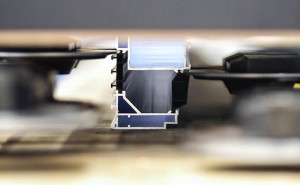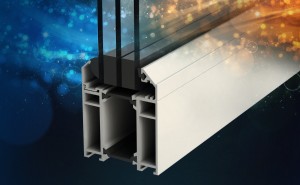The sleek design. The many possible colours. The scratch-resistance. Thermally broken aluminium window profiles have something for everyone. Even for persons looking for an environmentally-friendly solution. An overview of the advantages and disadvantages.

Everyone loves aluminium profiles
Window profiles are available in a range of shapes and colours. And in different materials. The most popular materials are wood, PVC and aluminium. Composites or hybrid windows have been introduced in the last two decades; frames in which materials are combined (for example: aluminium + PVC or aluminium + wood). However, a lot of people choose for aluminium.
An important argument is the weather-resistance. Rain, wind, snow, temperature fluctuations or a combination thereof; nothing affects it. The same applies to chemicals.
Why is that? Easy: aluminium creates an impenetrable aluminium oxide layer when it comes into contact with oxygen. This layer repairs itself automatically if damaged. This protects the metal against corrosion. Even after years of exposure to the sun, wind and rain, you will not see any discolouration, cracking or rust spots.
Aluminium is anodised to further improve this layer. This is an electrolytic surface treatment which artificially provides metals with an additional oxide layer with even better properties. This ensures that aluminium becomes stainless and scratch-resistant. Aluminium profiles are also extremely maintenance-friendly. A simple wash with a mild soap plus a rinse with clear water and you only need for it to dry and you're done!
One of the additional benefits of the oxide layer is that you can give the aluminium profiles any colour you want. The inside and outside can each have their own colour. The windows can always completely match the style of the façades and the interior.
Sleek and modern
When we talk about their look, we have one more trump card. Aluminium profiles are the perfect choice for persons who love a sleek, modern style: large glass surfaces finished with thin profiles. Aluminium makes this possible. The density of aluminium is 2.6 to 2.8 kg/dm3. For comparison: iron and steel are just below 8 kg/dm3. But aluminium is still extremely rigid and retains its shape. This “light metal” can easily handle the enormous weight of large windows, even with high efficiency or triple glazing.
This rigidity makes the profiles also very resistant against intrusion attempts. And aluminium is still easily modifiable. The melting temperature is “only” 660° C (compared to the 1,535° C of iron, for example). This makes aluminium ideal for extrusion. This is a manufacturing method for the production of window profiles where the material is pressed through a hole in a mould.
Nothing but good news. And this remains the case, even after we take a look at the disadvantages. Aluminium cancels noises but conducts heat. This made the metal unsuitable for window profiles until a few decades ago. The solution to this problem was a thermal barrier. A Polyamide, PVC, Noryl or ABS strip is added between the aluminium extrusions. These are plastics that do offer good thermal insulation. The problem of heat loss was solved immediately. Thermally broken aluminium profiles perform just as well as their wood or PVC peers in terms of U-value, enabling them to be used in low-energy and even passive houses.
The production costs were a second important disadvantage of aluminium for a long time. Extraction from bauxite demands tremendous amounts of energy, resulting in high costs. However, aluminium is 100% recyclable and the recycling process takes less than 5% of the energy needed for the production of primary aluminium. Secondary aluminium is equivalent to the original version in terms of quality. People call it “the green metal” for a reason!
- Peter De Roovere




Leave a comment